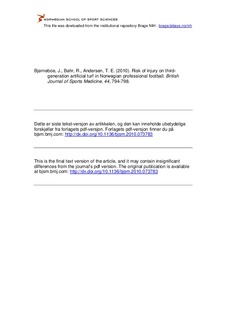| dc.contributor.author | Bjørneboe, John | |
| dc.contributor.author | Bahr, Roald | |
| dc.contributor.author | Andersen, Thor Einar | |
| dc.date.accessioned | 2011-04-06T09:20:14Z | |
| dc.date.available | 2011-04-06T09:20:14Z | |
| dc.date.issued | 2010-09 | |
| dc.identifier | Seksjon for idrettsmedisinske fag / Department of Sports Medicine | |
| dc.identifier.citation | British Journal of Sports Medicine. 2010, 44(11), 794-798 | en_US |
| dc.identifier.issn | 0306-3674 | |
| dc.identifier.uri | http://hdl.handle.net/11250/170745 | |
| dc.description | I Brage finner du siste tekst-versjon av artikkelen, og den kan inneholde ubetydelige forskjeller fra forlagets pdf-versjon. Forlagets pdf-versjon finner du på bjsm.bmj.com: http://dx.doi.org/10.1136/bjsm.2010.073783 / In Brage you'll find the final text version of the article, and it may contain insignificant differences from the journal's pdf version. The original publication is available at bjsm.bmj.com: http://dx.doi.org/10.1136/bjsm.2010.073783 | en_US |
| dc.description.abstract | Background: Artificial turf is used extensively in both recreational and elite football in areas with difficult climatic conditions. Objective: To compare the risk for acute injuries between natural grass (NG) and third-generation artificial turf (3GAT) in male professional football. Study design: Prospective cohort study.
Methods: All injuries sustained by players with a first-team contract were recorded by the medical staff of each club, from the 2004 throughout the 2007 season. An injury was registered if the player was unable to take fully part in football activity or match play. Results: A total of 668 match injuries, 526 on grass and 142 on artificial turf, were recorded. The overall acute match injury incidence was 17.1 (95% CI 15.8 to 18.4) per 1000 match hours; 17.0 (95% CI 15.6 to 18.5) on grass and 17.6 (95% CI 14.7 to 20.5) on artificial turf. Correspondingly, the incidence for training injuries was 1.8 (95% CI 1.6 to 2.0); 1.8 (95% CI 1.5 to 2.0) on grass and 1.9 (95% CI 1.5 to 2.2) on artificial turf respectively. No significant difference was observed in injury location, type or severity between turf types. Conclusion: No significant differences were detected in injury rate or pattern between 3GAT and NG in Norwegian male professional football. | en_US |
| dc.language.iso | eng | en_US |
| dc.publisher | BMJ | en_US |
| dc.subject | soccer injuries | en_US |
| dc.subject | natural grass | en_US |
| dc.subject | elite football | en_US |
| dc.subject | players | en_US |
| dc.subject | surface | en_US |
| dc.subject | turf toe | en_US |
| dc.subject | foot -- wounds & injuries | en_US |
| dc.subject | football | en_US |
| dc.subject | football injuries | en_US |
| dc.subject | synthetic sporting surfaces | en_US |
| dc.title | Risk of injury on third-generation artificial turf in Norwegian professional football | en_US |
| dc.type | Journal article | en_US |
| dc.type | Peer reviewed | en_US |
| dc.subject.nsi | VDP::Social science: 200::Social science in sports: 330::Other subjects within physical education: 339 | en_US |
| dc.source.pagenumber | 794-798 | en_US |
